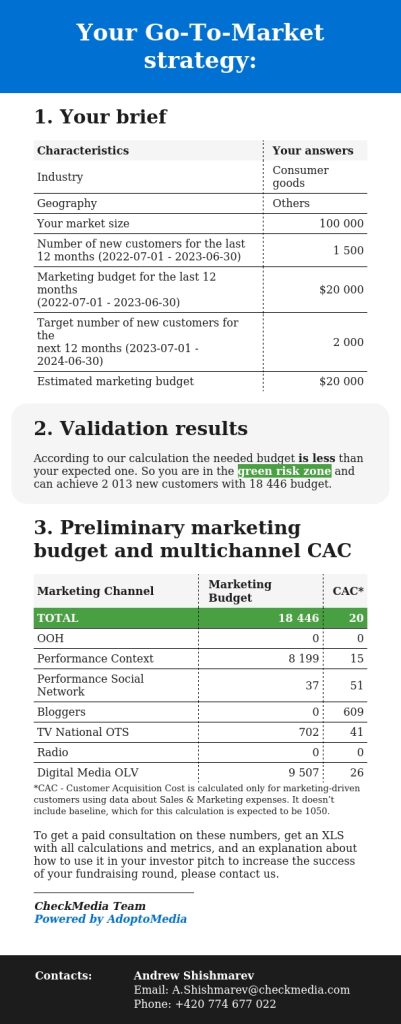
|
How to Leverage Omnichannel Marketing and Measure its Effectiveness?
As a business, you must be proactive to meet customers halfway and ensure that their experience with you, whatever point of interaction they come across or choose, is consistent with your brand and convenient.
Omnichannel marketing is a strategic approach that helps businesses to provide a unified shopping experience for clients through all channels of contact, including websites, brick-and-mortar stores, mobile apps, social media, and more.
In this blog post, we’ll look at omnichannel marketing and how businesses can use it to boost sales. We’ll also discuss some omnichannel marketing strategies and performance measurement tools so you can get up to speed on the latest developments.
What is omnichannel marketing?
Omnichannel marketing is the practice of providing a unified customer experience across multiple channels, both online and offline. It aims to ensure that customers can easily access and buy your products, regardless of channel, to maximize sales opportunities.
This strategy helps you create a comfortable shopping experience for your customers, allowing them to engage with your brand whenever they choose.
An omnichannel experience provides a seamless transition between channels, allowing customers to easily pick up where they left off. If a customer adds an item to their cart on your website but decides not to purchase it immediately, you can easily remind them of the item when they switch to another channel, like social media or in-store. In this fast-paced world with tons of distracting information, omnichannel marketing allows you to stay visible and accessible.
This strategy helps consolidate all marketing channels into one unified user experience and create an interconnected journey for customers so that there are no obstacles or inconveniences on their path to purchase.
Omnichannel marketing ties together elements such as website design, search engine optimization (SEO), digital ads, emails, and direct mail. It also looks at how customers interact with brands across different platforms.
By taking a holistic view of the customer journey, omnichannel marketing allows businesses to understand their customer’s needs better and provide them with an enjoyable shopping experience. Examples of omnichannel marketing tactics include mobile-friendly website design, in-store wi-fi for online shopping, and QR codes that link to product pages on smartphones. It also means a complex media mix of traditional and digital channels that allow businesses to achieve maximum coverage and effectiveness for ad campaigns.
The benefits of omnichannel marketing
Improved Customer Experience
When there are quickly loading images of your product, comprehensive description, convenient payment options and a unified experience across all channels, it is easier for customers to shop and interact with your brand, leading to better satisfaction.
Increased customer loyalty
If interactions with your brand are always convenient and enjoyable, customers are more likely to be loyal. They will also be more likely to recommend your products and services to others, which can result in more sales. When satisfied at every buying stage, people are not likely to look for other options.
More insights into customer behavior
Omnichannel marketing allows you to track a customer’s journey across all channels and gain insights into their behavior. The more data you gather, the easier it will be to get insights into your customer base and create more targeted and effective marketing campaigns.
Increased revenue
Properly implemented omnichannel marketing also leads to increased revenue and profits. First, your business has a broader reach as you now meet your customers everywhere they are, and they do not have to do a deep search to find your business and make a transaction. This fact is proven by statistical analysis that is used for building optimized media mixes.
Higher channel efficiency and effectiveness
Omnichannel marketing generates better results not only because you are catching customers everywhere they might go, but also because of the synergy that results from using certain marketing activities simultaneously. It means that some channels not only drive sales but also increase the efficiency of other channels.
A perfect example is the combination of TV and performance advertising. TV commercials build your brand awareness, so when a user is exposed to a performance ad for your product after seeing it on TV they are more likely to make a purchase, since they are familiar with it.
This is the main advantage of using omnichannel marketing campaigns. They build brand awareness through reach channels, which later transforms into brand search queries in performance advertising. Such queries are much cheaper than general queries. An example of a brand query would be looking up Uber, while a general query is looking up any taxi service.
Case study
- A car insurance marketplace was launched at the end of 2020. The initial media mix included performance channels (mainly search and contextual), but didn’t have reach channels. Performance ads in that campaign generated 3.3% of conversions. Later on, in May 2021 the brand launched a test TV and OOH flight to see how it affects the contribution to business KPIs. Analysis showed that the effectiveness of performance ads increased to 4.1% after the TV and OOH ads were in place.
It happened because reach channels drive search traffic, and TV gives you access to mass audiences.The people who saw ads for the service on TV or billboards chose the brand when shopping around and even looked it up intentionally. Then in September-October 2021, the brand launched a few more flights of reach advertising, which again boosted performance advertising effectiveness. In December 2021, conversions driven by performance ads more than doubled compared to figures before May 2021 reaching 7.2%. The brand continued using this combination of channels, and the following year, in autumn 2022, performance conversion was already 11.6%.
These calculations are made with marketing mix modeling tools, they can actually measure such changes in effectiveness and attribute them to specific channels. This information allows for an effective planning of future campaigns and optimal budget allocation.
- Another scenario where different channels complement each other in an omnichannel campaign is the combination of radio and digital OOH. In this case, people hear everything about the advantages of your product while waiting in traffic and at the same time see a catching visual on a billboard. And the next step would be to look up the product and buy it.
- One more way to combine different channels is to launch a TV flight simultaneously with ads on social media. In this case, you will be able to catch those who switched to their phones to scroll through their news feed during a commercial break.
- Some brands go even further and smoothly incorporate advertising into entertaining content that users are definitely not going to skip. You might have guessed that it’s about product placement in TV shows or movies. For example, a character going to MacDonald’s for a snack, or getting an Uber, or James Bond driving an Aston Martin.
Creating an omnichannel marketing strategy
Having an omnichannel marketing strategy is essential for building brand awareness and increasing sales. Focus on the following aspects to develop and implement an effective strategy:
Start With Data
Gather data from all channels to better understand your customers, their preferences and behavior. This will enable you to create more targeted campaigns and personalize ad messages. To get the most out of available data make sure that it is collected properly, specify the requirements to your agency or marketing department before launching a campaign. It’s necessary to know exactly how much money was spent on a certain channel in a given period and how it performed. We recommend discussing the requirements related to data collection with your analytical and measurement tools providers.
Use analytics
Planning and executing an omnichannel campaign is a challenging task, even if it’s for a single product. Luckily, with the high quality data you’ve gathered and advanced tools you can make this process much easier and faster. Choose the most effective and efficient combinations of media channels to achieve target KPIs or even go beyond. To know what works best you need a proper and accurate measurement system in place. You will find more about it further in the paragraph about performance measurement.
Set measurable goals
Setting measurable goals is important so you can track your progress and measure success. This could be increasing sales or app installs, reducing cart abandonment, or improving customer loyalty.
Create a unified content strategy
Make sure all channels have consistent messaging and visuals. This includes using the same tone of voice and design elements across channels.
Optimize for mobile
Mobile optimization is essential for omnichannel marketing today, as an increasing number of customers are using their mobile devices to shop. Make sure your website is optimized for mobile, from loading times to payment options. Here are some pitfalls to avoid in mobile targeting in 2023.
Leverage Automation
Automation can be used to streamline processes and improve efficiency, making it easier to manage multiple channels. Automation allows brands not only to engage with more customers at the same time through newsletters or chatbot conversations, but also to optimize media planning and budget allocation.
Seek to Help the Customer at Every Step of the Way
Finally, ensuring that you provide helpful and timely customer support across all channels is important. This is essential for creating a positive customer experience and can help increase loyalty, leading to more sales in the long run.
Crafting an omnichannel Go-to-Market strategy

|
If you are making a strategy for a new product or going to venture to a new market the process is complicated by the lack of historical data. Your goal is to avoid unnecessary media spends and invest just enough money to reach the target KPI. If this is your case, you can try an automated service for validating go-to-market strategies by CheckMedia. Answer seven questions in our chatbot service and within five minutes you will get an analysis with infographics that will show if your planned budget is enough to execute your GTM strategy successfully.
Such quick calculation is the result of combining AI technology with previously built metamodels. And it’s not just a general, one-size-fits-all analysis, because there are different models for each industry, including e-com, FMCG, fintech, pharmaceutical, crypto, retail, etc. You will also get a typical media mix that works best for your business vertical to help you achieve the target in terms of sales, number of new customers, and other business KPIs.
It’s also worth mentioning that at every stage of product development marketing mix structure should be different to ensure optimal budget allocation and effectiveness. Our service takes into account whether you are going to launch a new product, grow your market share, or exit the market when generating a Go-to-Market strategy.
Measuring the performance of omnichannel marketing campaigns
As we have mentioned, one of the benefits of omnichannel marketing is that some channels strengthen the effect of others. And while it’s perfect performance-wise, it makes the measurement process so much more complicated. That is why you require advanced tools that can attribute sales or other business KPI to the right channel, so that you know how to properly allocate your budget next time to maximize results.
Marketing attribution
Marketing attribution models is one of the tools that is often used for ad performance measurement. They can identify the user’s path to purchase and show what channel caused the conversion. But it’s not this simple with omnichannel marketing, because the last touch that resulted in the conversion might not have that much influence on it. Attribution usually overestimates the contribution of digital channels to KPIs, that is why the picture gets a little unclear. Anyway, with the introduction of iOS 14.5 version with stricter policies on users’ privacy, the use of Marketing Attribution has become quite limited without access to user data.
Marketing mix modeling
According to Deloitte, Marketing Mix Modeling is a tool that ensures upgrade of a company’s planning process. That is why you should have it in your measurement kit to be able to accurately measure the performance of every channel and optimize planning. Since it needs only aggregated data to make calculations, it complies with all the privacy regulations. At the same time it provides a highly accurate evaluation of channel performance. Here you can see a detailed comparison of three advanced MMM tools that use AI for assistance.
Complex MMM algorithms can clean the digital channels’ contribution to sales from the influence of TV commercials and show you the results that can be completely credited to a single channel. With enough historical data you can even enjoy the benefits of prescriptive analytics and choose among numerous what-if scenarios the most effective ones.
Conclusion
In today’s highly competitive world brands can’t leave customers’ sight for too long and need to be easily available, that’s why they turn to omnichannel marketing, which helps them meet these requirements. In addition to that, calculations prove that combining various communication channels generates far better results than using them separately, and you can’t argue with facts and figures.



